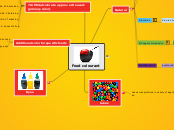af nurul husna 9 år siden
317
Food colourant

af nurul husna 9 år siden
317

Mere som dette
-To reinforce color
-Help to restore the original color
-To provide appealing and readily identifiable products
- Water soluble, color dissolutions
-Insoluble in oil, work well in higher moisture system
-Combining dyes with Aluminium Hydroxide
-Insoluble in water,lor by dispersion or suspensions
-Are derived from natural resources
-Derived from vegetables and fruit juice extracts
-Acidic condition-Red
-Basic condition-Blue
3. Ex: Fruit juices
2. pH range 3.5-7
Derived from fescue grass
3. Ex: Ice-cream and beverages
2. pH range 3.5-7.5
from beet
3. Ex: Dairy, food preparing and instant beverages
2. pH range 4 to 7
from totatoes
3. Ex: pickle, mustard, cereals and yogurt
2. pH range 3 to 7
3. Ex: beverages and dairy
2. pH range 2 to 8
3. Ex: chesse, snacks and potatoes
2. pH range 4 and above
1. Good heat and light stability